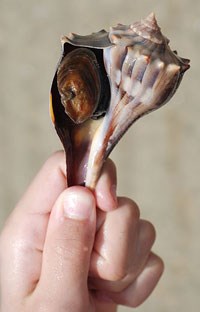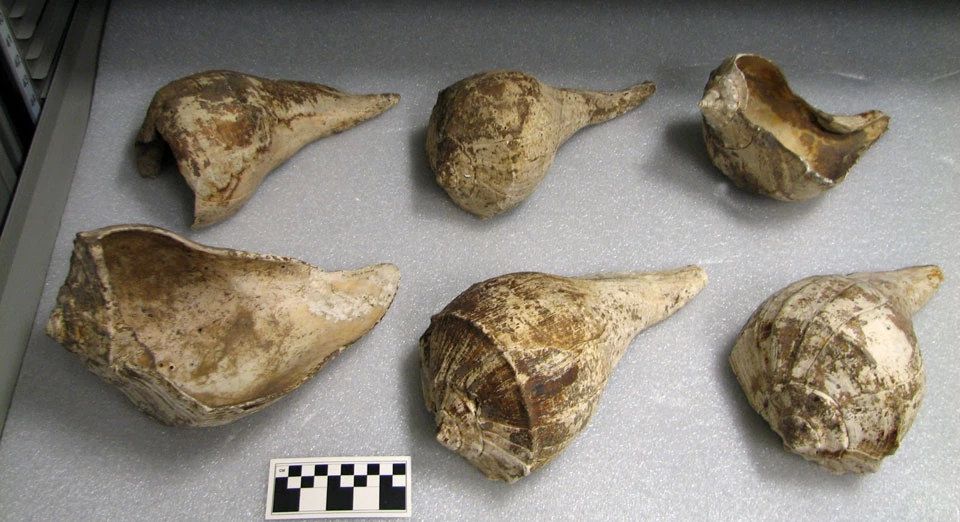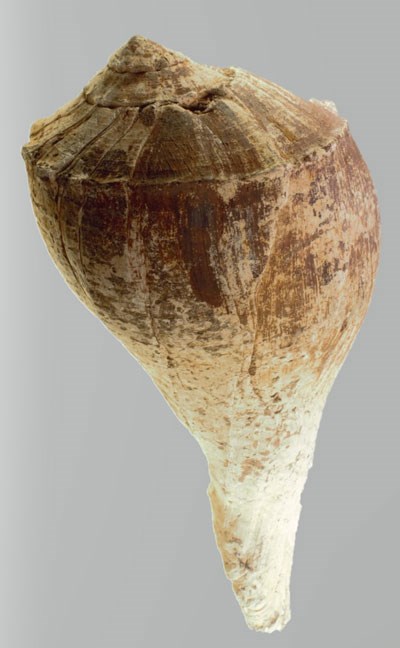Last updated: June 17, 2022
Article
Hopewell Culture Seashells

Wikimedia/Jarek Tuszyński
Written by Park Guide Sarah Hinkelman
Seashells are one of the most common souvenirs collected by people on their trip to the beach. Shells are found on almost every coast in North America including the coasts of lakes and rivers. They make excellent decorations, gifts, and keepsakes. The ancient people who were a part of the Hopewell culture in the Scioto River Valley collected seashells too, but for very different reasons than we do today.
The people who participated in the Scioto Hopewell culture collected many kinds of seashells, but the most common (and most impressive) shell found in the mounds and earthworks is the shell of the lightning whelk (Busycon perversum or sinistra). The lightning whelk is a type of sea snail that is carnivorous, meaning it eats meat such as the clams and oysters found at the bottom of the sea. This particular whelk can grow up to 40 cm or 16 inches in length. Its shell is unique and recognizable since it coils clockwise inward beginning at its left-sided opening, which is not common among sea snails. The lightning whelk is found in the waters of the Gulf of Mexico and along the Atlantic coast; the western coast of Florida seems to be the most likely source of the shells collected by ancient peoples who brought them to Ohio.

NPS Photo / Tom Engberg

NPS Photo / Andrew Weiland
Lightning whelk shells could have made their way to the Scioto River Valley in Ohio through travel, trade, or gifting. The Hopewell world was broad and encompassed almost the entire eastern half of North America, expanding as far west as Oklahoma and as far south as the Gulf of Mexico. The ancient people from the Scioto River Valley may have journeyed down the Gulf of Mexico to get the whelk shells as a part of a spiritual quest, often called vision quests, which are common in American Indian religious practices. Whelk shells may have also been passed along from Hopewell group to Hopewell group from the Gulf of Mexico to the Scioto River Valley. It is also possible that Hopewell groups from the south coast journeyed up to the Scioto Valley bringing the shells with them as gifts or offerings as they came to participate in the celebrations at the earthworks that are now protected as a part of Hopewell Culture National Historical Park.
These shells did not adorn the houses of prehistoric peoples as décor like modern interior decorators typically use seashells today. The shells collected by the people who participated in the Hopewell culture were used for sacred purposes. Historically, for many American Indian groups, shells symbolize birth, creation, and renewal. They are associated with the sea and therefore the underworld, a realm that is connected to both life and death. The lightning whelk shell’s left turning spiral is often interpreted as representation of the pathway of the sun and the cycle of life, birth to death. These large shells are never found in prehistoric houses belonging to individuals participating in the Hopewell culture, but are found only in ceremonial places alongside other special materials, altars, and the remains of important individuals within mounds and earthworks. The lightning whelk shells found in the mounds and earthworks in the Scioto River Valley were usually hollowed into containers or cups which would have been used to serve ceremonial drinks. The interior portion of the shell, called the columella, was used to create beads and pendants. Parts of the outer portion (lip) of the shell were used to make large round pendants called gorgets often carved with beautiful designs.
The beauty and symbolism of shells continues to fascinate us today. It is part of the reason we continue to collect and display them in our homes. For the ancient people who participated in the Hopewell Culture seashells carried a special meaning, do you have any shells that are meaningful to you?
